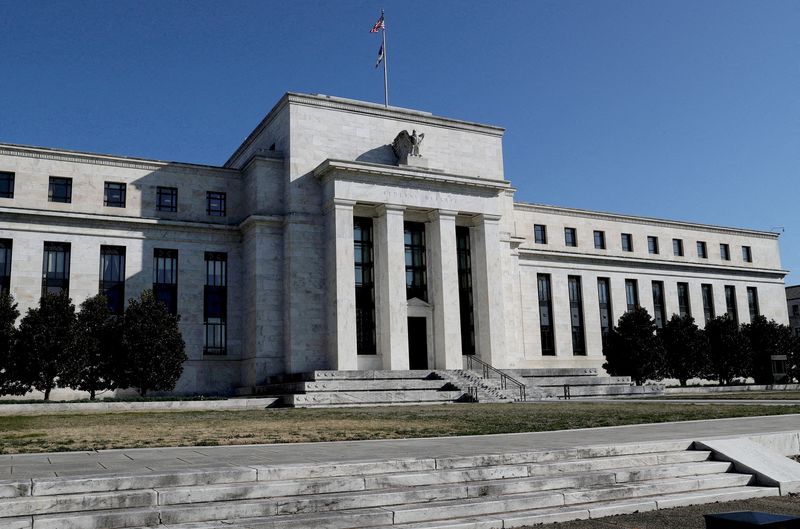Investing.com’s stocks of the week
By Indradip Ghosh
BENGALURU (Reuters) - The U.S. Federal Reserve will hold its key interest rate steady this year despite an expected recession, according to a Reuters poll of economists, who also said the risk of a U.S. default over the debt ceiling was higher compared to prior stand-offs.
Those concerns, along with failures of some regional banks, led markets to price in at least a 50 basis point cut by end-2023, an expectation that gained momentum after policymakers signaled a pause to the rate hiking campaign at the May 2-3 meeting.
However, U.S. central bankers reiterated the federal funds rate would stay high or could go even higher, not lower, despite 34 of 46 respondents to an additional question in the May 11-16 Reuters poll predicting a U.S. recession in 2023.
Over 60% or 75 of 116 economists predicted the Federal Open Market Committee, which hiked the interest rate by 25 basis points in early May to 5.00%-5.25%, said it would be there at end-2023.
While 14 expected the rate to be even higher at some point this year, three of them also had a cut penciled in to take it back to the current level. Thirty predicted no hike and at least a 25 basis point cut.
"Put simply, inflation is more than double the Fed's target rate and the unemployment rate is below every FOMC participant's estimate of the natural rate. These facts alone suggest the Fed's bias would be to hike rather than cut," said Michael Gapen chief U.S. economist at Bank of America (NYSE:BAC).
"In our view, rather than lean against a mild recession, the Fed would view it as an acceptable price for bringing inflation back down to target."
The world's largest economy, which likely expanded at an annualized rate of 1.1% last quarter, will grow 0.6% in this one before contracting 0.2% and 0.3% in the final two quarters of 2023, according to the poll.
Still, inflation was not forecast to fall to the central bank's 2% target until at least 2025.
The unemployment rate was expected to rise from its current 3.4% level to 4.2% by end-2023 and average 4.5% in 2024, still historically low compared to previous recessions.
But what could worsen that outlook of a mild economic downturn is the ongoing debt-limit crisis.
President Joe Biden and top lawmakers in Congress have about two weeks to strike a deal as the U.S. Treasury Department said it only expects to be able to pay the government's bills through June 1 without an increase to the $31.4 trillion debt limit.
Previous stand-offs have typically resulted in last-minute arrangements, but in 2011 the top-notch U.S. credit rating was downgraded for the first time.
A slight majority, 22 of 41 respondents, said the risk of a default was higher this time compared to prior episodes of debt ceiling brinkmanship. While 16 said the risk was the same, three said lower.
Elevated worries about a default will push U.S. Treasury yields higher over the coming weeks, a separate Reuters poll showed.
"No matter how you slice it, the U.S. faces tough choices to bring its fiscal house in order. However, further political brinkmanship - or even worse, failure to raise the debt limit - would be like adding salt to the wound," said Michael Gregory, deputy chief economist at BMO Capital Markets.
"If brinkmanship pushes the U.S. closer to X-date without a deal in place, then we're more likely to see market stress indicators amplify. The macroeconomic consequences of a short default would be somewhat more severe."
(For other stories from the Reuters global economic poll:)
